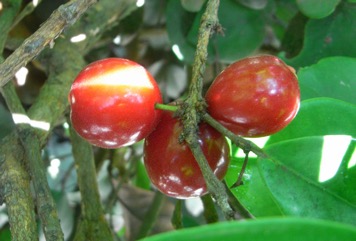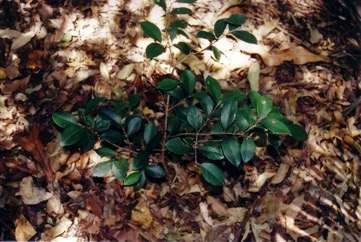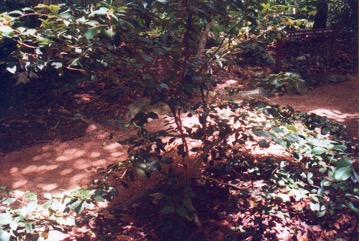Sweet cherry, Beach cherry, Cedar Bay Cherry

A tropical plant. It is native to NE Australia. It is a tropical rainforest species. Often it occurs in coastal scrub. They can tolerate salt laden winds. They require a well drained soil. Trees will grow in full sunlight or heavy shade. They can tolerate very slight frosts. In the Cairns Botanical Gardens.
Also known as:
Agashiru, Pohon jambu ceri pantai, Unuoi
Synonyms
- Eugenia carissoides F. Muell.
- Eugenia hypospodia F. Muell.
- Eugenia kangeanensis Valeton
- Eugenia koolauensis var. glabra O. Deg.
- Eugenia macrohila C.T.White & W.D.Francis
- Eugenia rariflora Benth.
- Eugenia rariflora var. parvifolia Hillebr.
- Eugenia reinwardtiana f. lutea H.St.John
- Eugenia waianensis O.Deg.
- Jossinia reinwardtiana (Blume) Blume
- Jossinia tahitensis Nadeaud
- Myrtus reinwardtiana Blume
Edible Portion
- Fruit
Where does Sweet cherry grow?
Found in: American Samoa, Asia, Australia, Brazil, Cook Islands, East Timor, Fiji, Hawaii, Indonesia, Marquesas, Micronesia, Niue, Pacific, Palau, Papua New Guinea, PNG, Rotuma, Samoa, SE Asia, South America, Timor-Leste, Tonga, Torres Strait, United States
Notes: There are about 550 Eugenia species. They are mostly in tropical and subtropical South America.
Status: Fruit are rich in Vitamin C.
Growing Sweet cherry, Beach cherry, Cedar Bay Cherry
Cultivation: They can be grown from seed. They can also be grown from cuttings but the cuttings are slow to form roots.
Edible Uses: The flesh of the fruit is eaten. It can be used for jams and sauces.
Production: Trees are very slow growing but commence flowering while still small. They can fruit after 2 years. Trees flower and fruit throughout the year. Most commonly flowering is June to February with fruit maturing August to March.
Nutrition Info
per 100g edible portion| Edible Part | Energy (kcal) | Protein (g) | Iron (mg) | Vitamin A (ug) | Vitamin c (mg) | Zinc (mg) | % Water |
|---|---|---|---|---|---|---|---|
| Fruit | 74 | 1.9 | 1.1 | - | - | 1.1 | 70.8 |
Sweet cherry, Beach cherry, Cedar Bay Cherry Photos



References
Anon., 2003, Native Plants for the Fitzroy basin. Society for Growing Australian Plants Inc. (Rockhampton Branch) p 55
Barwick, M., 2004, Tropical and Subtropical Trees. A Worldwide Encyclopedic Guide. Thames and Hudson p 175
Cooper W & Cooper W T, 1994, Fruits of the Rain Forest. RD Press p 122
Cooper, W. and Cooper, W., 2004, Fruits of the Australian Tropical Rainforest. Nokomis Editions, Victoria, Australia. p 342
Elliot, W.R., & Jones, D.L., 1992, Encyclopedia of Australian Plants suitable for cultivation. Vol 4. Lothian. p 246
Facciola, S., 1998, Cornucopia 2: a Source Book of Edible Plants. Kampong Publications, p 157
Fell, D.G. & Stanton, D.J., 2015: The vegetation and flora of Mabuyag, Torres Strait, Queensland. Memoirs of the Queensland Museum – Culture 8(1):1-33. Brisbane. ISSN 1440-4788.
Fern, K., 2012, Tropical Species Database http://theferns.info/tropical/
Franklin, J., Keppel, G., & Whistler, W., 2008, The vegetation and flora of Lakeba, Nayau and Aiwa Islands, Central Lau Group, Fiji. Micronesica 40(1/2): 169–225, 2008
Hedrick, U.P., 1919, (Ed.), Sturtevant's edible plants of the world. p 300 (As Eugenia rariflora)
Hibbert, M., 2002, The Aussie Plant Finder 2002, Florilegium. p 99
INFOODSUpdatedFGU-list.xls
Jackes, B.R., 2001, Plants of the Tropics. Rainforest to Heath. An Identification Guide. James Cook University. p 68
Jones D, L, 1986, Ornamental Rainforest Plants in Australia, Reed Books, p 69, 340
Leiper, G & Houser, J., Mutooroo. Plant Use by Australian Aboriginal People. Assembly press, Queensland. (As Syzygium carissioides)
Lorenzi, H., Bacher, L., Lacerda, M. & Sartori, S., 2006, Brazilian Fruits & Cultivated Exotics. Sao Paulo, Instituto Plantarum de Estuados da Flora Ltda. p 456
Melzer, R. & Plumb, J., 2011, Plants of Capricornia. Belgamba, Rockhampton. p 246
Molyneux, B. and Forrester, S., 1997, The Austraflora A-Z of Australian Plants. Reed. p 95
Mua Bioversity Profile, 2013, Profile for Management of the Habitats and Related Ecological and Cultural Resources of Mua Island. Torres Strait Regional Authority Land & Sea Management Unit. p 142
Nicholson, N & H., 1996, Australian Rainforest Plants 3, Terania Rainforest Publishing. NSW. p 28
Paczkowska, G . & Chapman, A.R., 2000, The Western Australian Flora. A Descriptive Calatogue. Western Australian Herbarium. p 386
Radke, P & A, Sankowsky, G & N., 1993, Growing Australian Tropical Plants. Frith & Frith, Australia. p 36
Recher, P, 2001, Fruit Spirit Botanical Gardens Plant Index. www.nrg.com.au/~recher/ seedlist.html p 2 (As Eugenia carissoides)
Sukarya, D. G., (Ed.) 2013, 3,500 Plant Species of the Botanic Gardens of Indonesia. LIPI p 275
Tanaka,
Townsend, K., 1994, Across the Top. Gardening with Australian Plants in the tropics. Society for Growing Australian Plants, Townsville Branch Inc. p 207
Wheeler, J.R.(ed.), 1992, Flora of the Kimberley Region. CALM, Western Australian Herbarium, p 531
Whistler, W.A., 2004, Rainforest Trees of Samoa. Isle Botanica Honolulu, Hawaii. p 116
Williams, K.A.W., 1999, Native Plants of Queensland Volume 4. Keith A.W. Williams North Ipswich, Australia. p 190
World Checklist of Useful Plant Species 2020. Royal Botanic Gardens, Kew